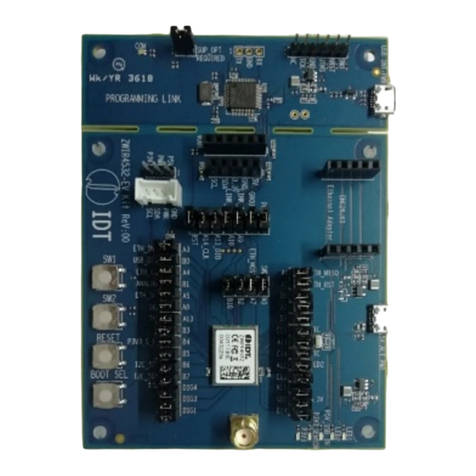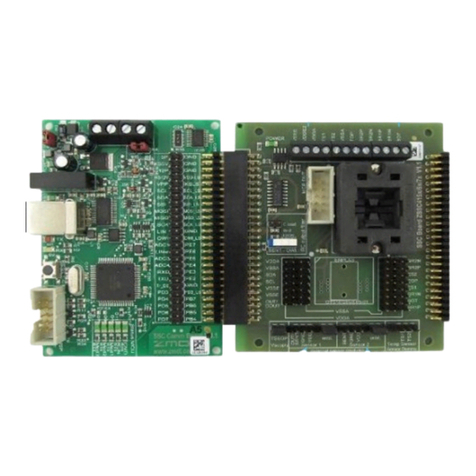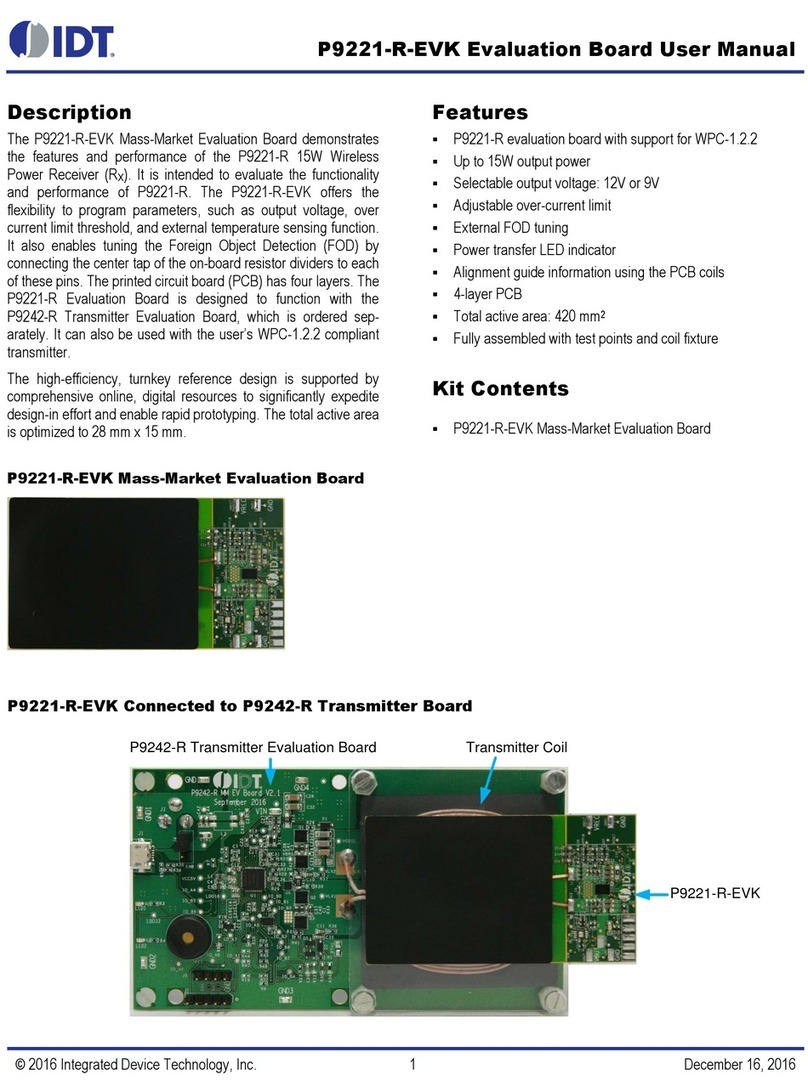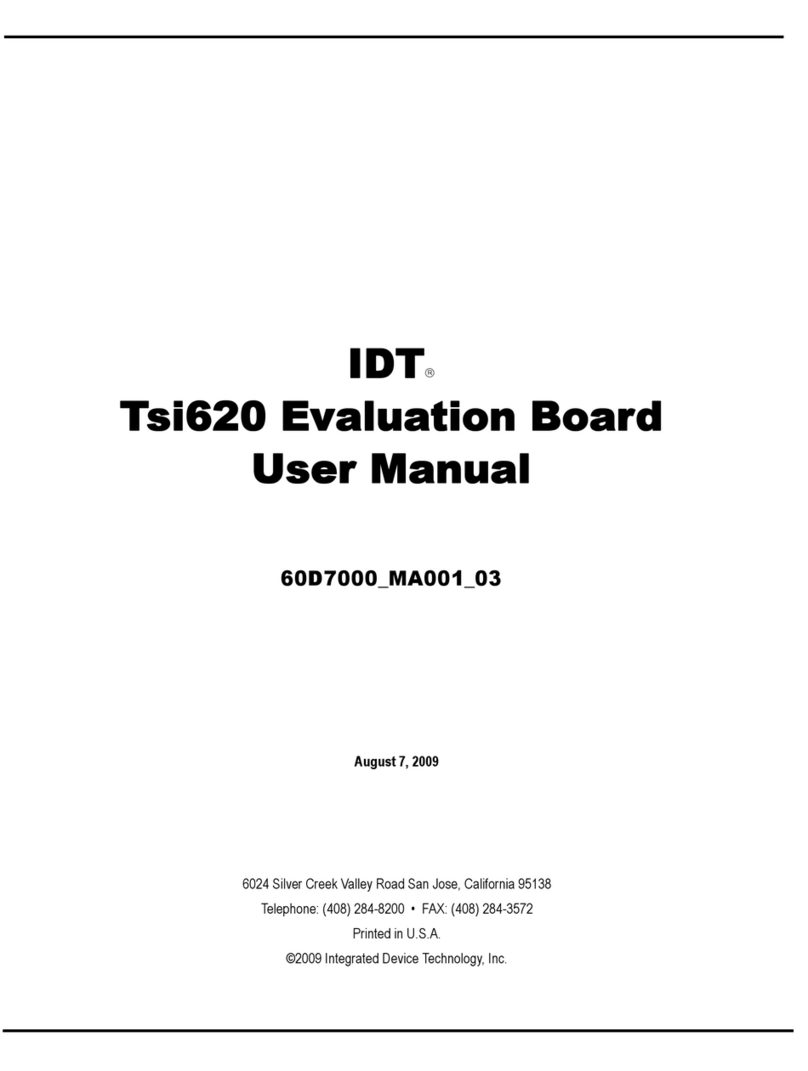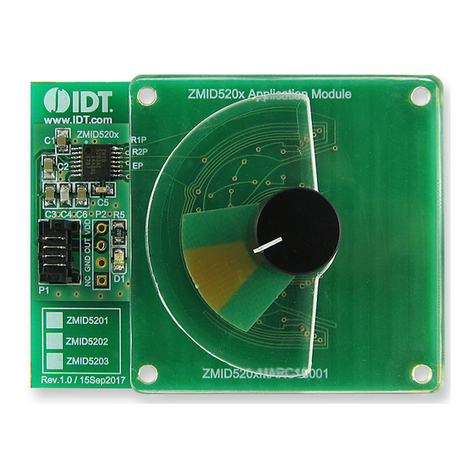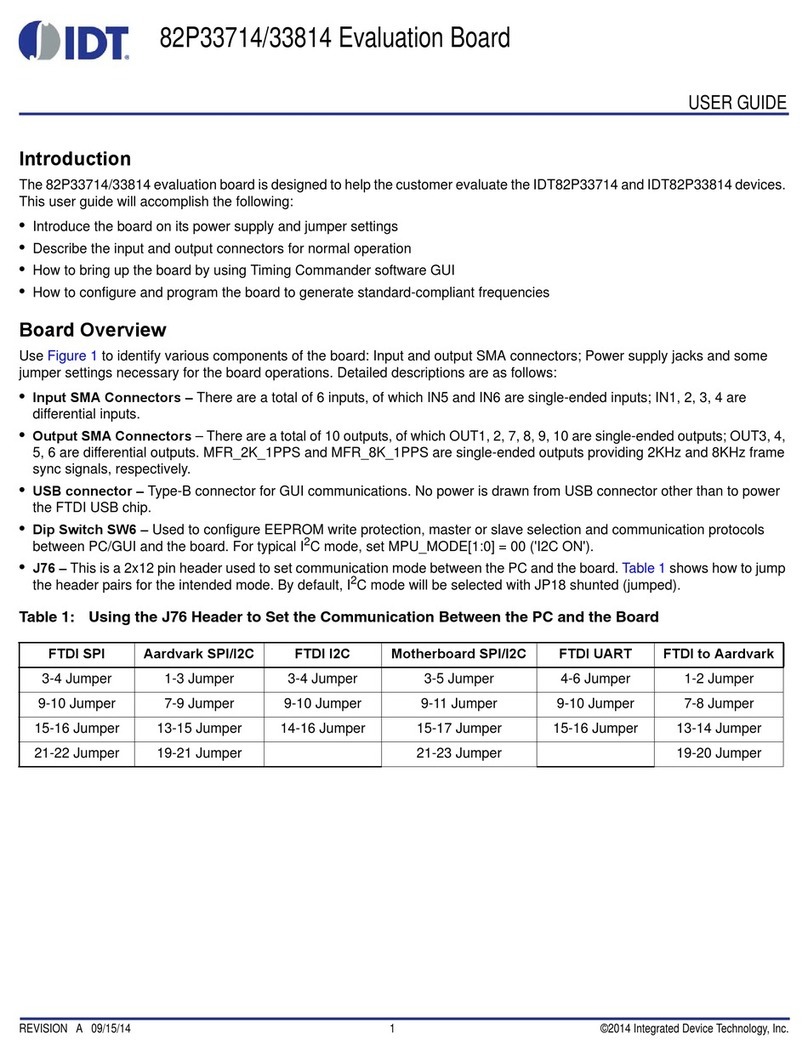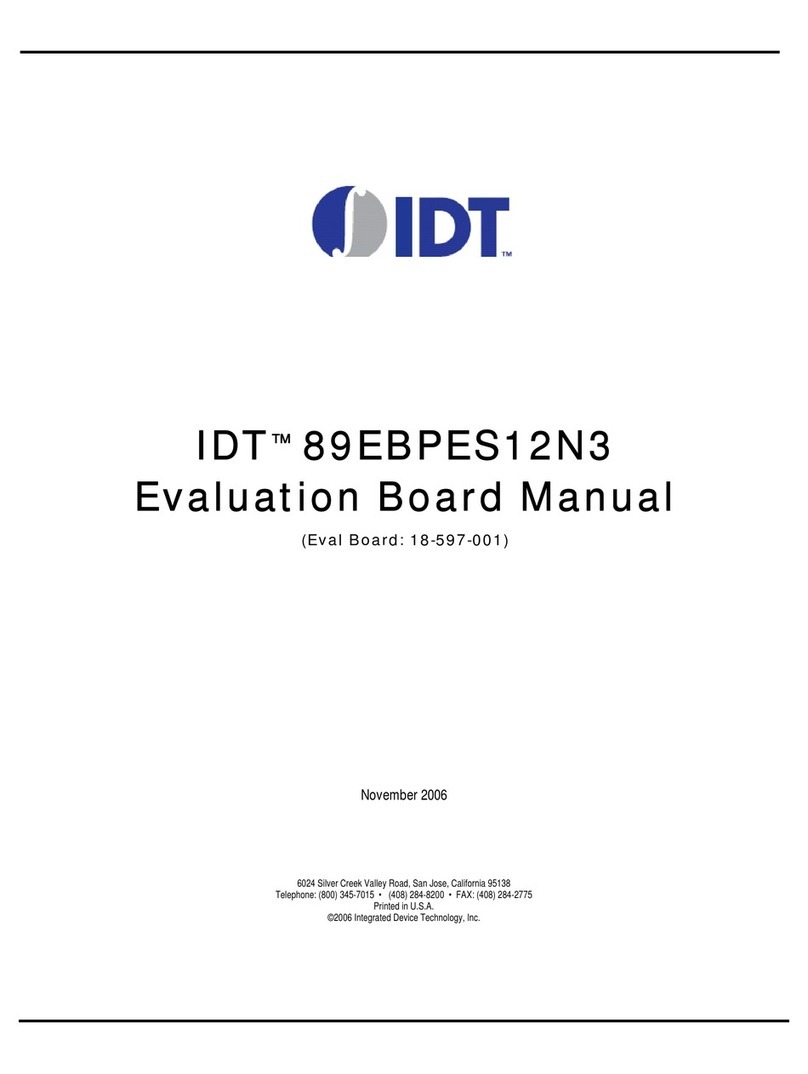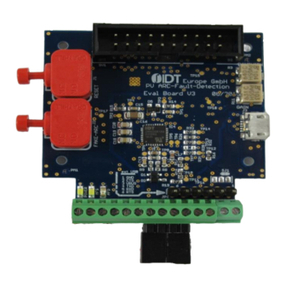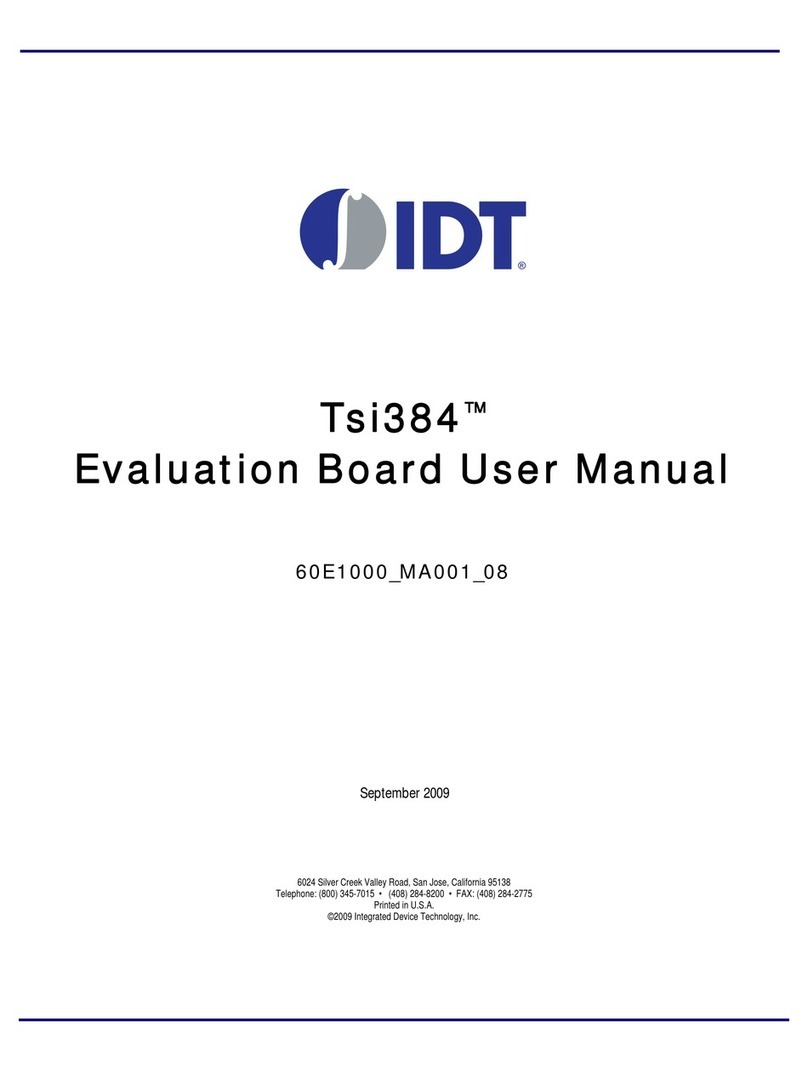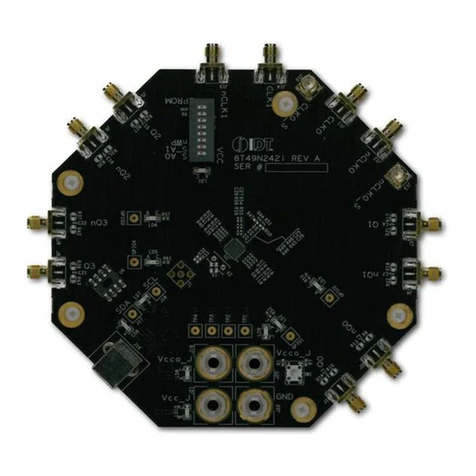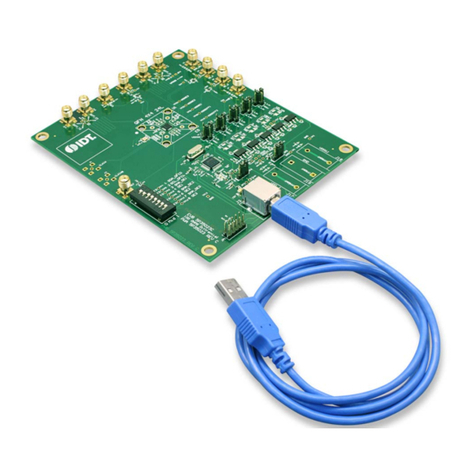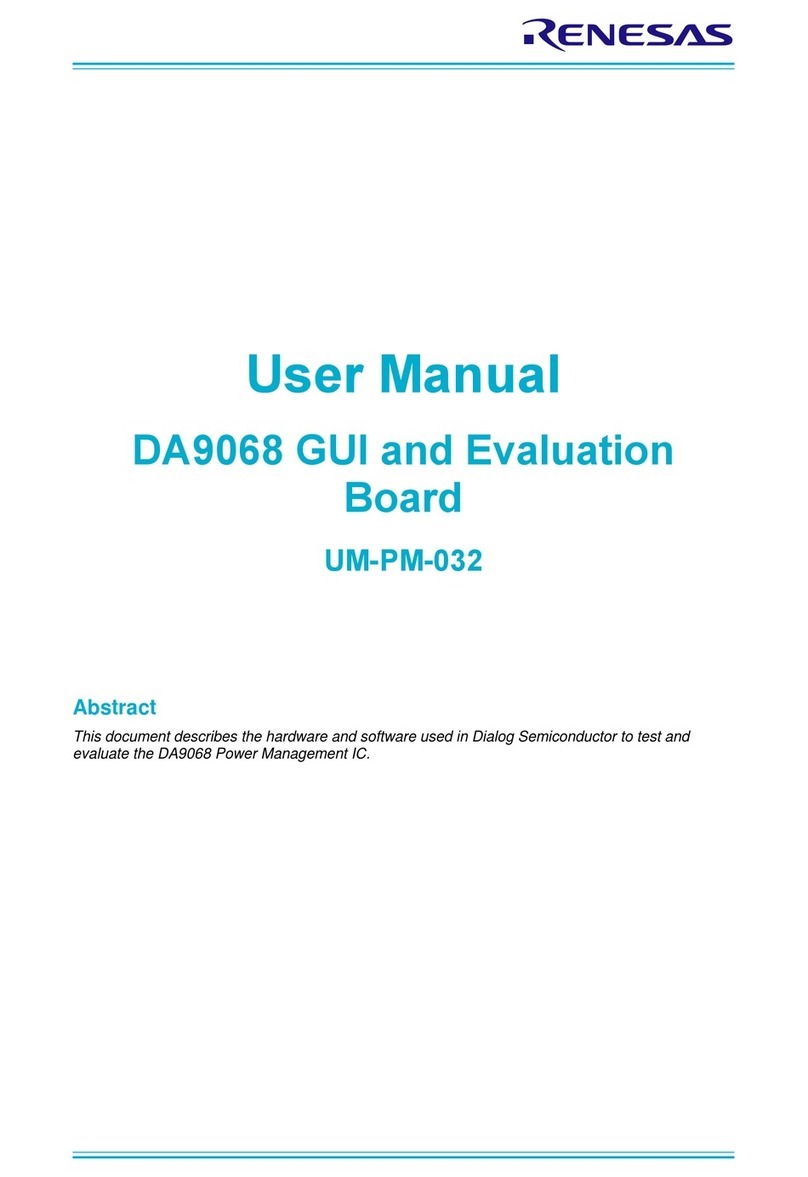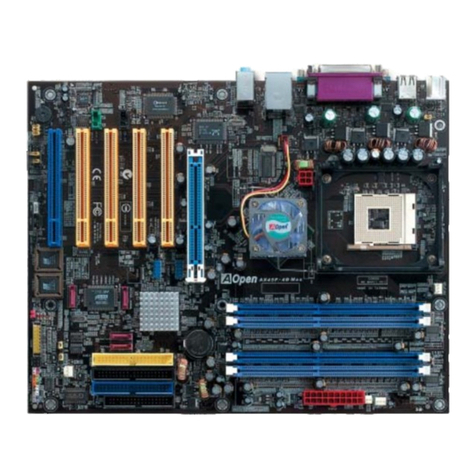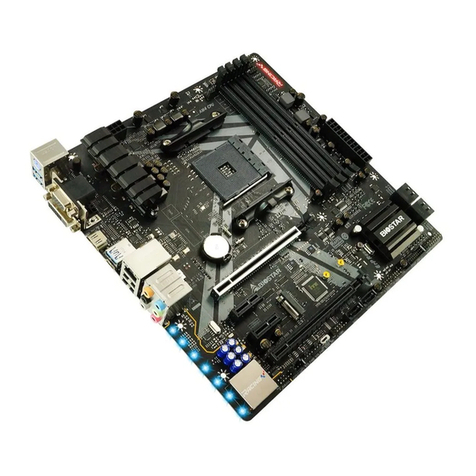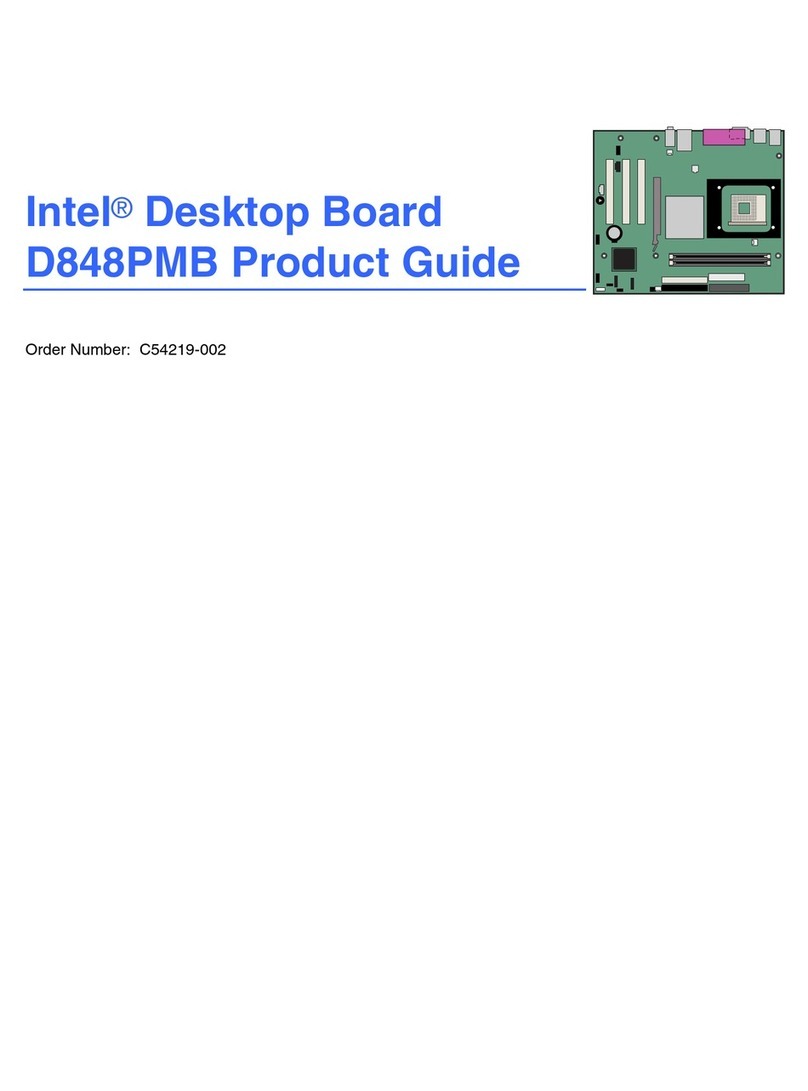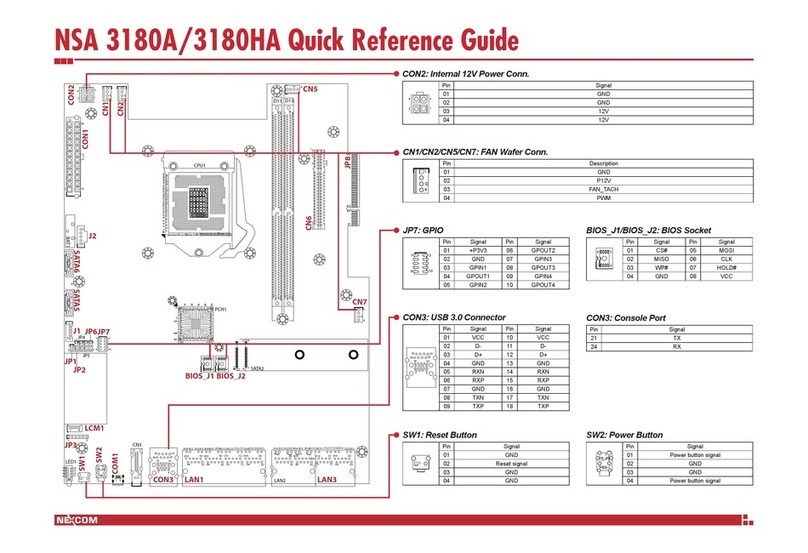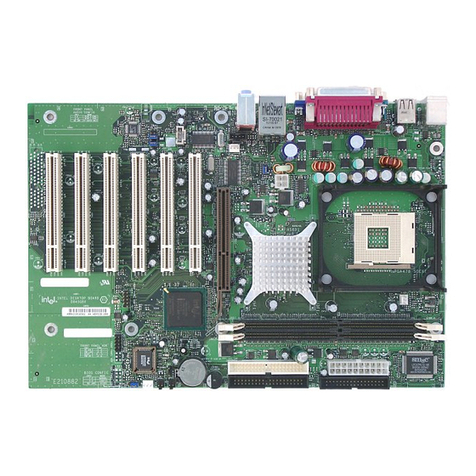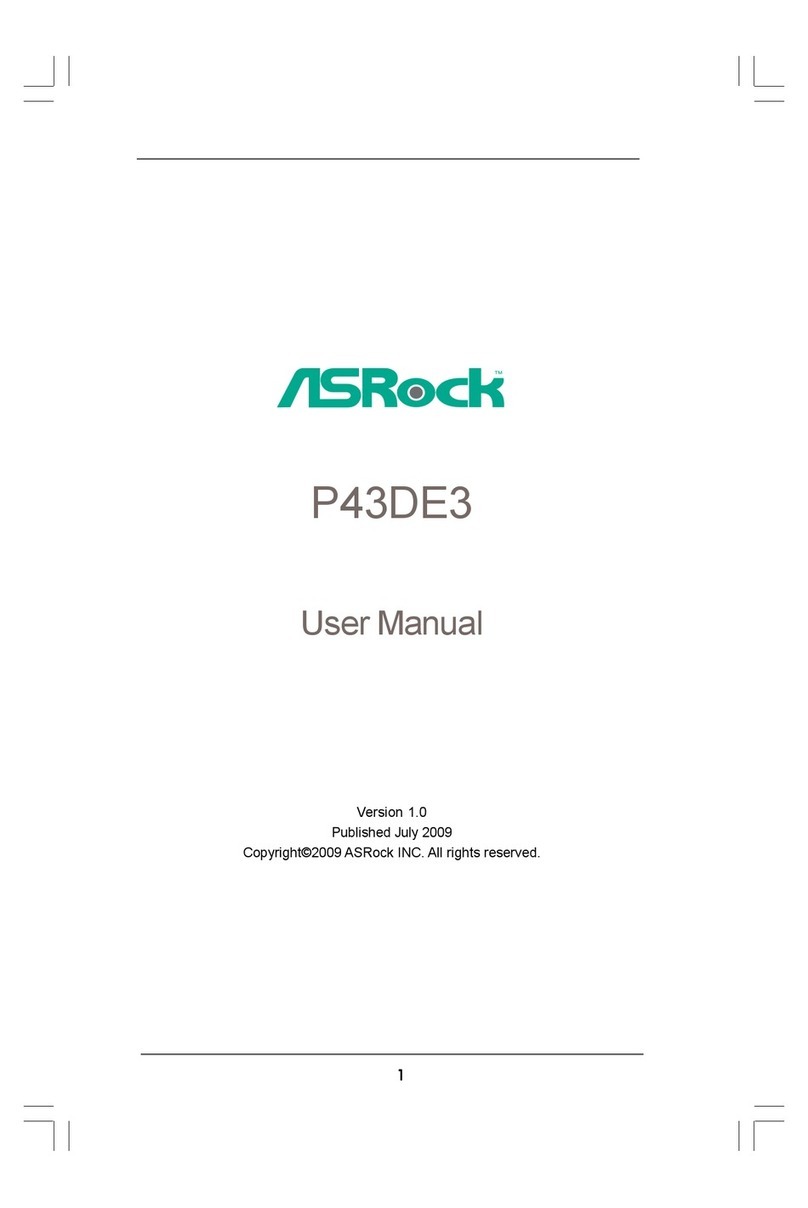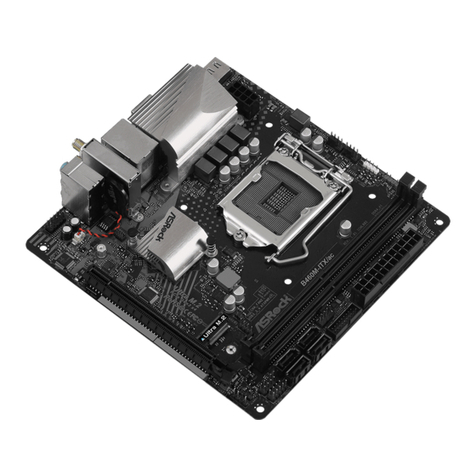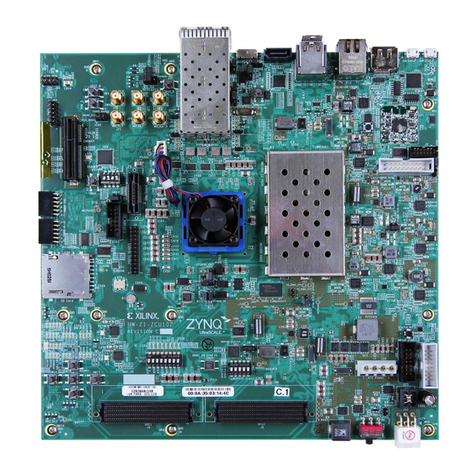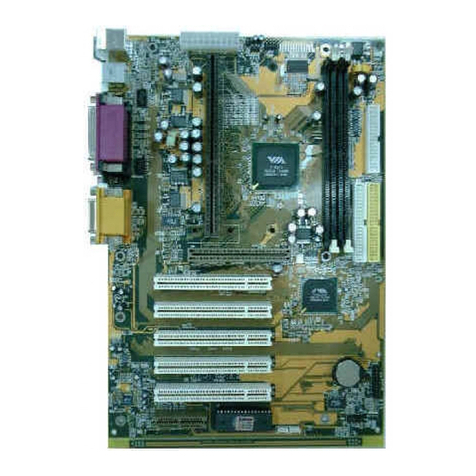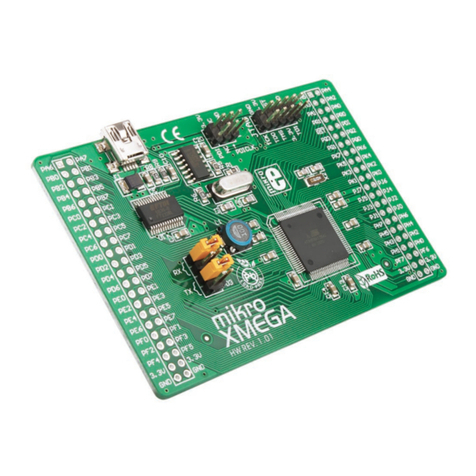IDT 89EB-LOGAN-19 User manual

®
February 2011
6024 Silver Creek Valley Road, San Jose, California 95138
Telephone: (800) 345-7015 • (408) 284-8200 • FAX: (408) 284-2775
Printed in U.S.A.
©2011 Integrated Device Technology, Inc.
IDT™89EB-LOGAN-19
Evaluation Board Manual
(Evaluation Board: 18-692-000)

DISCLAIMER
Integrated Device Technology, Inc. reserves the right to make changes to its products or specifications at any time, without notice, in order to improve design or performance
and to supply the best possible product. IDT does not assume any responsibility for use of any circuitry described other than the circuitryembodied in an IDT product. The
Company makes no representations that circuitry described herein is free from patent infringement or other rights of third parties which may result from its use. No license is
granted by implication or otherwise under any patent, patent rights or other rights, of Integrated Device Technology, Inc.
Boards that fail to function should be returned to IDT for replacement. Credit will not be given for the failed boards nor will a
Failure Analysis be performed.
LIFE SUPPORT POLICY
Integrated Device Technology's products are not authorized for use as critical components in lifesupport devices or systemsunless a specific written agreement pertaining to
such intended use is executed between the manufacturer and an officer of IDT.
1. Life support devices or systems are devices or systems which (a) are intended for surgical implant into the body or (b) support or sustain life and whose failure to perform,
when properly used in accordance with instructions for use provided in the labeling, can be reasonably expected to result in a significant injury to the user.
2. A critical component is anycomponents of a life supportdevice or system whosefailure to performcanbe reasonably expected tocausethefailure of thelifesupportdevice
or system, or to affect its safety or effectiveness.
IDT, the IDT logo, and Integrated Device Technology are trademarks or registered trademarks of Integrated Device Technology, Inc.

Notes
89EB-LOGAN-19 Evaluation Board i February 16, 2011
Table of Contents
®
Description of the EB-LOGAN-19 Evaluation Board
Introduction.....................................................................................................................................1-1
Board Features...............................................................................................................................1-2
Hardware................................................................................................................................1-2
Software..................................................................................................................................1-2
Other.......................................................................................................................................1-2
Revision History..............................................................................................................................1-2
Installation of the EB-LOGAN-19 Evaluation Board
EB-LOGAN-19 Installation..............................................................................................................2-1
PCI Express Mezzanine and Edge Adapters..................................................................................2-1
Hardware Description.....................................................................................................................2-3
Reference Clocks............................................................................................................................2-4
Global Reference Input Clocks...............................................................................................2-4
Local Port Input Clocks...........................................................................................................2-6
Power Sources.......................................................................................................................2-7
PCI Express Analog Power Voltage Regulator.......................................................................2-8
PCI Express Digital Power Voltage Converter........................................................................2-8
PCI Express Transmitter Analog Voltage Converter..............................................................2-8
Core Logic Voltage Converter................................................................................................2-8
3.3V I/O Voltage Regulator.....................................................................................................2-8
Power-up Sequence for PES24NT24G2................................................................................2-8
Heatsink Requirement....................................................................................................................2-8
Reset...............................................................................................................................................2-9
Fundamental Reset................................................................................................................2-9
Downstream Reset.................................................................................................................2-9
Stack Configuration................................................................................................................2-9
Boot Configuration Vector.............................................................................................................2-10
SMBus Interfaces..........................................................................................................................2-11
SMBus Slave Interface.........................................................................................................2-11
SMBus Master Interface.......................................................................................................2-12
JTAG Header................................................................................................................................2-12
PCI Express Connectors...............................................................................................................2-13
EB-LOGAN-19 Board Figure........................................................................................................2-15
Software for the EB-LOGAN-19 Eval Board
Introduction.....................................................................................................................................3-1
Device Management Software........................................................................................................3-1
Device Drivers.................................................................................................................................3-1
Schematics
Schematics.....................................................................................................................................4-1

IDT Table of Contents
89EB-LOGAN-19 Evaluation Board ii February 16, 2011
Notes

Notes
89EB-LOGAN-19 Evaluation Board iii February 16, 2011
List of Tables
®
Table 2.1 EB-LOGAN-19 Global Clock Select ....................................................................................2-4
Table 2.2 Clock Buffer Input Sources .................................................................................................2-5
Table 2.3 Global Reference Input Clock Frequency Select ................................................................2-5
Table 2.4 Onboard Clock Generator Frequency Select ......................................................................2-6
Table 2.5 Onboard Reference Clock Generator Access Points .........................................................2-6
Table 2.6 EB24NT24G2 Port Clock Select .........................................................................................2-6
Table 2.7 EB-LOGAN-19 Slot Clock Select ........................................................................................2-6
Table 2.8 CLKMODE Selection PES24NT24G2 ................................................................................2-7
Table 2.9 EPS12V 24-pin Power Connector - J6 ...............................................................................2-7
Table 2.10 EPS12V 8-Pin Connector - J5 ............................................................................................2-8
Table 2.11 Ports in Each Stack ..........................................................................................................2-10
Table 2.12 Boot Configuration Vector Signals ....................................................................................2-10
Table 2.13 Boot Configuration Vector Switches S5, SW8 - SW10 .....................................................2-10
Table 2.14 Slave SMBus Interface Connector ....................................................................................2-11
Table 2.15 SMBus Slave Interface Address Configuration .................................................................2-12
Table 2.16 JTAG Connector Pin Out ..................................................................................................2-12
Table 2.17 PCI Express x8 Connector Pinout ....................................................................................2-13

IDT List of Tables
89EB-LOGAN-19 Evaluation Board iv February 16, 2011
Notes

Notes
89EB-LOGAN-19 Evaluation Board v February 16, 2011
List of Figures
®
Figure 1.1 Function Block Diagram of the EB-LOGAN-19 Evaluation Board ......................................1-1
Figure 2.1 Bifurcated and Merged Mezzanine Cards ..........................................................................2-1
Figure 2.2 MiniSAS Mezzanine Adapter ............................................................................................2-2
Figure 2.3 EB-LOGAN-19 iSAS-to-SATA Breakout Cable ..................................................................2-2
Figure 2.4 PCIe x1 Edge-to-SATA Adapter ........................................................................................2-3
Figure 2.5 EB-LOGAN-19 Evaluation Main Board ..............................................................................2-3
Figure 2.6 12PACK PCIe Slots Breakout Daughter Board .................................................................2-4
Figure 2.7 Differential Jumper Arrangement .......................................................................................2-4
Figure 2.8 Reference Clock Configuration ..........................................................................................2-5
Figure 2.9 EB24NT24G2 Evaluation Board ......................................................................................2-15

IDT List of Figures
89EB-LOGAN-19 Evaluation Board vi February 16, 2011
Notes

Notes
89EB-LOGAN-19 Evaluation Board 1 - 1 February 16, 2011
®
Chapter 1
Description of the EB-LOGAN-19
Evaluation Board
Introduction
The 89HPES24NT24G2 switch is a member of the IDT PCI Express® Inter-Domain Switch family of
products. It is a PCIe® Base Specification 2.1 compliant (Gen2) 24-lane, 24-port switch. The EB-LOGAN-
19 Evaluation Board provides an evaluation platform for the PES24NT24G2 switch and for other members
of this switch family including PES16NT16G2 and PES12NT12G2.
Detailed information related to configuration of number of ports and lanes in the switch device can be
found in the Device User Manual and the Device Datasheet. The evaluation board, along with additional
adapters and daughter boards provided by IDT, can be configured to test every possible combination of the
number of lanes and ports offered by the switch. Advanced capabilities such as switch partitioning, NTB,
DMA and local port clocking can be evaluated with the evaluation board.
The EB-LOGAN-19 brings out all 24 lanes of the device to two Mezzanine connectors and two SAS
connectors (see Figure 1.1) located close to the device - one connector perstack of 4 lanes. Various types
of daughter cards (provided by IDT) can then be plugged into the Mezzanine connectors to facilitate
connectivity to one x8 or two x4 or four x2 or eight x1 link partners. Link partners may be plugged directly
into these daughter cards or they can be connected to thesedaughter cards via SAS or SATA cables and a
different board with PCIe slots known as the 12-PACK board (provided by IDT). Given that majority of the
hosts / servers offer PCIe standard slots, IDT provides the necessary adapter cards that may be plugged
into these host / server slots as well as the cables that connect such adapters to the daughter cards which
in turn are plugged into the main evaluation board on which the IDT PCIe switch device is populated.
The EB-LOGAN-19 is also used by IDT to reproduce system-level hardware or software issues reported
by customers. Figure 1.1 illustrates the functional block diagram representing the main parts of the EB-
LOGAN-19 board.
Figure 1.1 Function Block Diagram of the EB-LOGAN-19 Evaluation Board

IDT Description of the EB-LOGAN-19 Evaluation Board
89EB-LOGAN-19 Evaluation Board 1 - 2 February 16, 2011
Notes Board Features
Hardware
PES24NT24G2 PCIe 24-port switch
– Twenty four ports (each x1) - for port 8 and higher, adjacent ports may be combined to create x2,
x4 or x8 ports
– PCIe Base Specification Revision 2.1 compliant (Gen2 SerDes speeds of 5 GT/S)
– Up to 2048 byte maximum Payload Size
– Automatic lane reversal and polarity inversion supported on all lanes
– Automatic per port link width negotiation to x8, x4, x2, x1
– Power on reconfiguration via optional serial EEPROM connected to the SMBUS Master interface
Upstream, Downstream Ports
– The EB-LOGAN-19 has minimum of one port configured as upstream port to be plugged into a
host slot through an adaptor and a cable.
– Up to 23 ports can be configured as downstream ports, for PCIe endpoint add-on cards to be
plugged in. The slot connectors can be configured to be x1, x2, x4 or x8, but are mechanically
open-ended on one side to allow card widths greater than x8 (e.g. x16) to be populated.
– When used in multi-partition mode, the device can be programmed through the serial EEPROM
to generate the appropriate number of upstream and downstream ports per partition.
Numerous user selectable configurations set using onboard jumpers and DIP-switches
– Source of clock - host clock or onboard clock generator
– Two clock rates (100/125 MHz) from an onboard clock generator
– Flexible clocking modes
• Common clock
• Non-common clock
• Local port clocking on ports that support this feature
– Boot mode selection
SMBUS Slave Interface (4 pin header)
SMBUS Master Interface connected to the Serial EEPROMs through I/O expander
Push button for Warm Reset
Many LEDs to display status, reset, power, hotplug, etc.
JTAG connector to the PES24NT24G2 JTAG pins.
Software
There is no software or firmware executed on the board. However, useful software is provided along
with the Evaluation Board to facilitate configuration and evaluation of the PES24NT24G2 within host
systems running popular operating systems.
Installation programs
– Operating Systems Supported: WindowsServer200x, WindowsXP, Vista, Linux
GUI based application for Windows and Linux
– Allows users to view and modify registers in the PES24NT24G2
– Binary file generator for programming the serial EEPROMs attached to the SMBUS.
Other
SMBUS cable may be required for certain evaluation exercises.
SMA connectors are provided on the EB-LOGAN-19 board for clock outputs.
Revision History
April 13, 2010: Initial publication of evaluation board manual.

IDT Description of the EB-LOGAN-19 Evaluation Board
89EB-LOGAN-19 Evaluation Board 1 - 3 February 16, 2011
Notes April 23, 2010: Updated Schematics in Chapter 4.
February 16, 2011: Changed default settings from Off to On in Tables 2.3 and 2.4.

IDT Description of the EB-LOGAN-19 Evaluation Board
89EB-LOGAN-19 Evaluation Board 1 - 4 February 16, 2011
Notes

Notes
89EB-LOGAN-19 Evaluation Board 2 - 1 February 16, 2011
®
Chapter 2
Installation of the EB-LOGAN-19
Evaluation Board
EB-LOGAN-19 Installation
This chapter discusses the steps required to configure and install the EB-LOGAN-19 evaluation board.
All available DIP switches and jumper configurations are explained in detail.
The primary installation steps are:
1. Configure jumper/switch options suitable for the evaluation or application requirements.
2. Connect PCI Express endpoint cards to the downstream port PCIe slots on the evaluation board.
3. Make sure that the host system (motherboard with root complex chipset) is powered off.
4. Connect the evaluation board to the host system.
5. Apply power to the host system.
The EB-LOGAN-19 board is typically shipped with all jumpers and switches configured to their default
settings. In most cases, the board does not require further modification or setup however please visit IDT
website and fill out the Technical Support Request form at http://www.idt.com/?app=TechSupport for other
configurations.
PCI Express Mezzanine and Edge Adapters
The PCI Express lanes are broken out to four Mezzanine connectors on EB-LOGAN-19 Evaluation
Board. The adapter cards are used to convert Mezzanine connector into PCI Express slot connector(s) or
Internal mini SAS (iSAS) connectors or both. A Bifurcated Mezzanine Card has two mechanical x8 PCIe
Slots (x4 electrically) while a Merged Mezzanine Card has single x8 PCIe Slot. Pictured in Figure 2.1.
Figure 2.1 Bifurcated and Merged Mezzanine Cards

IDT Installation of the EB-LOGAN-19 Evaluation Board
89EB-LOGAN-19 Evaluation Board 2 - 2 February 16, 2011
Notes Pictured in Figure 2.2 is the mini-SAS Mezzanine card which consists of two iSAS and two SATA
connectors. Each iSAS connector supports up to PCI Express x4 width and the SATA connectors are used
for clock and reset signals of each x4 or less stack/port. An iSAS-to-SATA breakout cable shown in Figure
2.3 is used connect from iSAS to edge adapter and/or 12PACK.
Figure 2.2 MiniSAS Mezzanine Adapter
Figure 2.3 EB-LOGAN-19 iSAS-to-SATA Breakout Cable
The PCI Express Edge to SATA Adapter, pictured in Figure 2.4, can be inserted into any physical PCIe
slot on a host system and in combination with mini-SAS Mezzanine Card, such as the one in Figure 2.2, to
form a link between evaluation main board and the host system. There are 5 SATA connectors which one
connector (J7) is for clock and reset, and the rest supports one PICe lane per SATA connector. The edge
adapters can be inserted into a mechanical x1 or greater slot.
SAS (x4) – four
SATA (x1)
breakout cable
SAS (x4) – four
SATA (x1)
breakout cable

IDT Installation of the EB-LOGAN-19 Evaluation Board
89EB-LOGAN-19 Evaluation Board 2 - 3 February 16, 2011
Notes
Figure 2.4 PCIe x1 Edge-to-SATA Adapter
Hardware Description
The PES24NT24G2 is a 24-lane, 24-port PCI Express® switch. It is a peripheral chip that performs PCI
Express based switching with a feature set optimized for high performance applications such as servers
and storage. It provides fan-out and switching functions between a PCI Express upstream port and down-
stream ports or peer-to-peer switching between downstream ports. Furthermore, up to eight ports can be
configured as NTB ports for multi-root application.
The EB-LOGAN-19 Main Board, shown in Figure 2.5, will support up to 4 PCI Express downstream
ports and up to 23 ports when using two 12PACK Daughter Boards.
Basic requirements for the board to run are:
– Hostsystem witha PCIExpress rootcomplex supportingx1 configurationthrough aPCI Express
x1 slot.
– – x1, x2, x4, or x8 PCI Express Endpoint Cards.
Figure 2.5 EB-LOGAN-19 Evaluation Main Board
Mezztotwox4
slot connectors
x4 iSAS connectors
DUT on bottom side
Mezztotwox4
slot connectors
x4 iSAS connectors
DUT on bottom side

IDT Installation of the EB-LOGAN-19 Evaluation Board
89EB-LOGAN-19 Evaluation Board 2 - 4 February 16, 2011
Notes
Figure 2.6 12PACK PCIe Slots Breakout Daughter Board
Reference Clocks
Global Reference Input Clocks
The PES24NT24G2 requires two differential reference clocks. The EB-LOGAN-19 derives these clocks
from SMA connectors (J17, J20, J66, J67), clockbuffer (U50), or SATA connectors (J21, J22) as described
in Table 2.1 and Figures 2.7 and 2.8.
Figure 2.7 Differential Jumper Arrangement
Global
Clock# Jumper Selection
0J18 [1-3 / 2-4] SMA (J66/J67)
[5-7 /6-8] From Clock Buffer U51 (default)
[7-9 / 8-10] SATA, J21
1J19 [1-3 / 2-4] SMA (J17/J20)
[5-7 /6-8] From Clock Buffer U51 (default)
[7-9 / 8-10] SATA, J22
Table 2.1 EB-LOGAN-19 Global Clock Select
On-Board
Clock Gen 1:12
Buffer
SATA
SMA
clk[0:11]
8-PIN EPS12V
24-PIN ATX
+12
+3.3 +12
S
L
O
T
1
1
x2
Data
SATA
CLK
S
A
T
A
S
A
T
A
S
L
O
T
1
0
x4
Data
SATA
CL K
S
A
T
A
S
A
T
A
S
A
T
A
S
A
T
A
S
L
O
T
9
x2
Data
SATA
CLK
S
A
T
A
S
A
T
A
S
L
O
T
8
x8
Data
SATA
CLK
S
A
T
A
S
A
T
A
S
A
T
A
S
A
T
A
S
A
T
A
S
A
T
A
S
A
T
A
S
A
T
A
S
L
O
T
7
x2
Data
SATA
CL K
S
A
T
A
S
A
T
A
S
L
O
T
6
x4
Data
SATA
CLK
S
A
T
A
S
A
T
A
S
A
T
A
S
A
T
A
S
L
O
T
5
x2
Data
SATA
CLK
S
A
T
A
S
A
T
A
S
L
O
T
4
x8
Data
SATA
CLK
S
A
T
A
S
A
T
A
S
A
T
A
S
A
T
A
S
A
T
A
S
A
T
A
S
A
T
A
S
A
T
A
S
L
O
T
3
x2
Data
SATA
CLK
S
A
T
A
S
A
T
A
S
L
O
T
2
x4
Data
SATA
CLK
S
A
T
A
S
A
T
A
S
A
T
A
S
A
T
A
S
L
O
T
1
x2
Data
SATA
CLK
S
A
T
A
S
A
T
A
S
L
O
T
0
x8
Data
SATA
CLK
S
A
T
A
S
A
T
A
S
A
T
A
S
A
T
A
S
A
T
A
S
A
T
A
S
A
T
A
S
A
T
A
On-Board
Clock Gen 1:12
Buffer
SATA
SMASMA
clk[0:11]
8-PIN EPS12V
24-PIN ATX
+12
+3.3 +12
S
L
O
T
1
1
x2
Data
SATA
CLK
S
A
T
A
S
A
T
A
S
L
O
T
1
0
x4
Data
SATA
CL K
S
A
T
A
S
A
T
A
S
A
T
A
S
A
T
A
S
L
O
T
9
x2
Data
SATA
CLK
S
A
T
A
S
A
T
A
S
L
O
T
8
x8
Data
SATA
CLK
S
A
T
A
S
A
T
A
S
A
T
A
S
A
T
A
S
A
T
A
S
A
T
A
S
A
T
A
S
A
T
A
S
L
O
T
7
x2
Data
SATA
CL K
S
A
T
A
S
A
T
A
S
L
O
T
6
x4
Data
SATA
CLK
S
A
T
A
S
A
T
A
S
A
T
A
S
A
T
A
S
L
O
T
5
x2
Data
SATA
CLK
S
A
T
A
S
A
T
A
S
L
O
T
4
x8
Data
SATA
CLK
S
A
T
A
S
A
T
A
S
A
T
A
S
A
T
A
S
A
T
A
S
A
T
A
S
A
T
A
S
A
T
A
S
L
O
T
3
x2
Data
SATA
CLK
S
A
T
A
S
A
T
A
S
L
O
T
2
x4
Data
SATA
CLK
S
A
T
A
S
A
T
A
S
A
T
A
S
A
T
A
S
L
O
T
1
x2
Data
SATA
CLK
S
A
T
A
S
A
T
A
S
L
O
T
0
x8
Data
SATA
CLK
S
A
T
A
S
A
T
A
S
A
T
A
S
A
T
A
S
A
T
A
S
A
T
A
S
A
T
A
S
A
T
A
1
3
5
7
9
11
2
4
6
8
10
12
IOA
IOB
IOC
IOD
1
3
5
7
9
11
2
4
6
8
10
12
IOA
IOB
IOC
IOD 10-129-11IOD <-> COM
8-107-9IOC <-> COM
4-63-5IOB <-> COM
2-41-3IOA <-> COM
JMP2JMP1CONNECTION
10-129-11IOD <-> COM
8-107-9IOC <-> COM
4-63-5IOB <-> COM
2-41-3IOA <-> COM
JMP2JMP1CONNECTION

IDT Installation of the EB-LOGAN-19 Evaluation Board
89EB-LOGAN-19 Evaluation Board 2 - 5 February 16, 2011
Notes
Figure 2.8 Reference Clock Configuration
By default the clock buffer derives its clock from a common source. Thecommon source can be thehost
system’s reference clock, the onboard clock generator, or SATA connector (J8). See Table 2.2.
.
The frequency of the global reference clock input may be selected by the Clock Frequency Select
(GCLKFEL) pin to be either 100 MHz or 125 MHz as described in Table 2.3.
The source for the onboard clock is the ICS841484 clock generator device (U49) connected to a 25MHz
oscillator (X1). When using the onboard clock generator, the output frequency is fixed at 100MHz. There-
fore, ICS_FS (S10, bit 1) is ON as the default setting. See Table 2.4.
Jumper Selection
J6 [1-3 / 2-4] SMA (J5/J7)
[5-7 / 6-8] Onboard Clock Generator (U49)
[7-9 / 8-10] SATA (J8) (default)
Table 2.2 Clock Buffer Input Sources
Global Clock Frequency Switch - SW10[2
SW10[2] Clock Frequency
ON 100 MHz (Default)
OFF 125 MHz
Table 2.3 Global Reference Input Clock Frequency Select

IDT Installation of the EB-LOGAN-19 Evaluation Board
89EB-LOGAN-19 Evaluation Board 2 - 6 February 16, 2011
Notes
The output of the onboard clock generator is accessible through two yellow colored loop connectors
located on the Evaluation Board. See Table 2.5. This can be used to connect a scope for probing or
capturing purposes and cannot be used to drive the clock from an external source.
Local Port Input Clocks
Associated with some ports is a port reference clock input (PxCLK). Depending on the port clocking
mode, a differential reference clock is driven into the device on the corresponding PxCLKP and PxCLKN
pins. The frequency of a port reference clock input is always 100 MHz. Table 2.6 lists the possible sources
for the port reference clock input, and Table 2.7 lists the possible sources for the slot clock input.
Onboard Clock Frequency Switch - S10[1]
S10[1] Clock Frequency
ON 100 MHz (Default)
OFF 125 MHz
Table 2.4 Onboard Clock Generator Frequency Select
Onboard Reference Clock Output (Differential)
J119 Positive Reference Clock
J120 Negative Reference Clock
J121 SATA Reference Clock
Table 2.5 Onboard Reference Clock Generator Access Points
Port # Header Selection
8J13 [1-3 / 2-4] Onboard Clock Generator (U118)
[5-7 / 6-8] Slot Clock Header (J31)
[7-9 / 8-10] SATA (J62) (default)
16 J15 [1-3 / 2-4] Onboard Clock Generator (U120)
[5-7 / 6-8] Slot Clock Header (J33)
[7-9 / 8-10] SATA (J64) (default)
Table 2.6 EB24NT24G2 Port Clock Select
Slot/Port # Header Selection
8J31 [1-3 / 2-4] Onboard Clock Generator (U118)
[3-5 / 4-6] From Clock Buffer (default)
[7-9 / 8-10] To P08CLK Clock Header (J13)
[9-11 / 8-10] SATA (J35)
Table 2.7 EB-LOGAN-19 Slot Clock Select (Part 1 of 2)

IDT Installation of the EB-LOGAN-19 Evaluation Board
89EB-LOGAN-19 Evaluation Board 2 - 7 February 16, 2011
Notes
CLKMODE Selection
All ports in the PES24NT24G2 device (upstream and downstream) use global clocked mode. The port
clocking mode of a port is determined by the state of the CLKMODE[1:0] pins in the boot configuration
vector as shown in Table 2.8. This field determines the initial value of the Slot Clock Configuration (SCLK)
field in each port’s PCI Express Link Status (PCIELSTS) register. The SCLK field controls the advertise-
mentof whetherornot theport usesthe samereferenceclock sourceas thelink partner.A oneinthe SCLK
field indicates that the port and its link partner use the same reference clock source. This is defined as
Common Clock Configuration by the PCI Express Base Specification. A zero in the SCLK field indicates
that the port and its link partner do not use the same reference clock source.
Power Sources
Power for the PES24NT24G2 and all downstream ports will be generated from the 12V from an external
power connector. See Table 2.9. A 12V to 3.3V DC-DC converter will be used to provide power to five
switching regulators to generate VDDCORE, VDDPEA, VDDPETA, VDDPEHA, and VDDIO voltages. The
3.3V from the DC-DC converter will be used to power the clock buffers and circuitries.
The external power supply connectors are 24-pin (J69) and 8-pin (J68) molex connector as described in
Tables 2.9 and 2.10. The +12V3 is used to power PES32NT24AG2 and downstream slots 16 and 20. The
+12V2 is used to power downstream slots 8 and 12.
12 J32 [1-3 / 2-4] From Clock Buffer (default)
[3-5 / 4-6] SATA (J36)
16 J33 [1-3 / 2-4] Onboard Clock Generator (U120)
[3-5 / 4-6] From Clock Buffer (default)
[7-9 / 8-10] To P16CLK Clock Header (J15)
[9-11 / 8-10] SATA (J37)
20 J34 [1-3 / 2-4] From Clock Buffer (default)
[3-5 / 4-6] SATA (J38)
SW10[8]
CLKMODE[0] SW10[7]
CLKMODE[1] Port 0
SCLK Port[23:1]
SCLK
ON ON 0 0
OFF ON 1 0
ON OFF 0 1
OFF OFF 1 1
Table 2.8 CLKMODE Selection PES24NT24G2
Pin Signal Pin Signal
1+3.3V 13 +3.3V
2+3.3V 14 -12V
3GND 15 GND
4+5V 16 PS_ON
5GND 17 GND
Table 2.9 EPS12V 24-pin Power Connector - J6 (Part 1 of 2)
Slot/Port # Header Selection
Table 2.7 EB-LOGAN-19 Slot Clock Select (Part 2 of 2)

IDT Installation of the EB-LOGAN-19 Evaluation Board
89EB-LOGAN-19 Evaluation Board 2 - 8 February 16, 2011
Notes
The power on switch located at S1 can be used to control the supply power from the external power
supply connector. Add a shunt to W27 to enable power on switch.
PCI Express Analog Power Voltage Regulator
A voltage regulator (U65) provides a 2.5V PCI Express analog power voltage (shown as VDDPEHA) to
the PES24NT24G2.
PCI Express Digital Power Voltage Converter
A separate voltage regulator (U62) provides a 1.0V PCI Express analog power voltage (shown as
VDDPEA) to the PES24NT24G2.
PCI Express Transmitter Analog Voltage Converter
A separate voltage regulator (U68) provides a 1.0V PCI Express transmitter analog voltage (shown as
VDDPETA) to the PES24NT24G2.
Core Logic Voltage Converter
A separate voltage regulator (U59) provides the 1.0V core voltage (VDDCORE) to the PES24NT24G2.
3.3V I/O Voltage Regulator
A separate voltage regulator (U56) provides the 3.3V I/O voltage (VDDIO) to the PES24NT24G2.
Power-up Sequence for PES24NT24G2
During power supply ramp-up, VDDCORE must remain at least 1.0V below VDDIO at all times. There
are no other power-up sequence requirements for the various operating supply voltages.
Heatsink Requirement
The EB-LOGAN-19 evaluation board utilizes a heatsink with integrated fan.
6+5V 18 GND
7GND 19 GND
8PWR_OK 20 NC
95VSB 21 +5V
10 +12V3 22 +5V
11 +12V3 23 +5V
12 +3.3V 24 GND
Pin Signal Pin Signal
1GND 5+12V1
2GND 6+12V1
3GND 7+12V2
4GND 8+12V2
Table 2.10 EPS12V 8-Pin Connector - J5
Pin Signal Pin Signal
Table 2.9 EPS12V 24-pin Power Connector - J6 (Part 2 of 2)
Table of contents
Other IDT Motherboard manuals
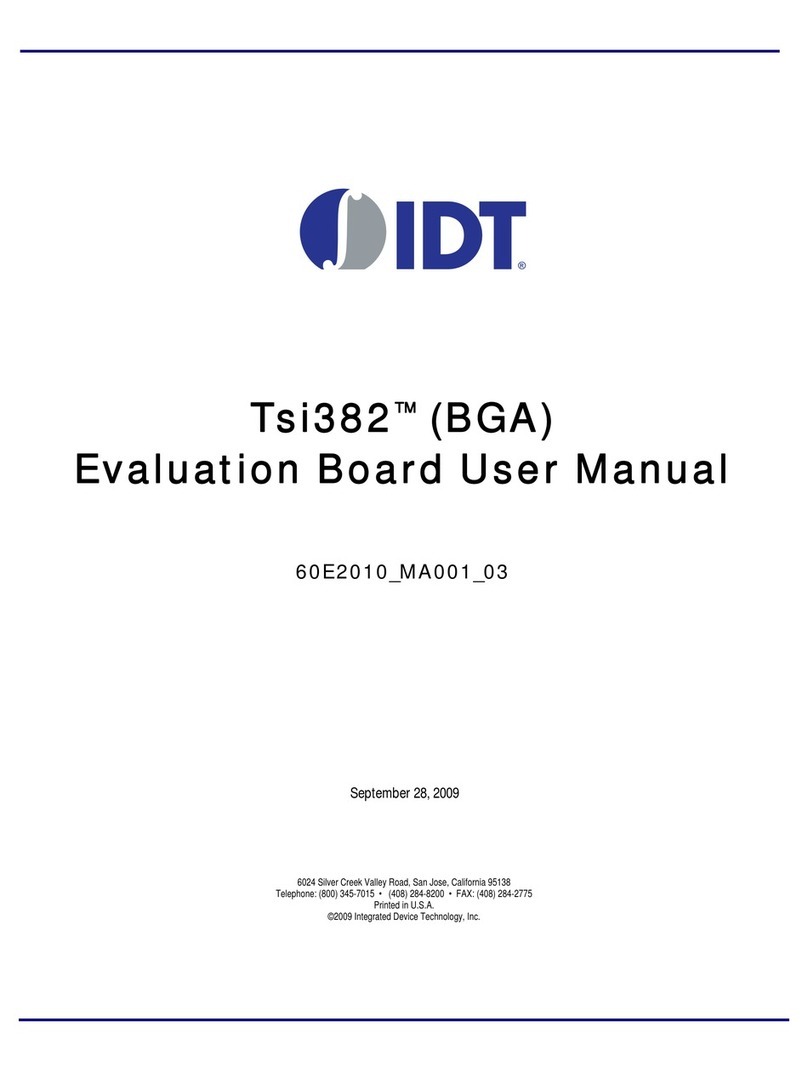
IDT
IDT Tsi382 LQFP User manual
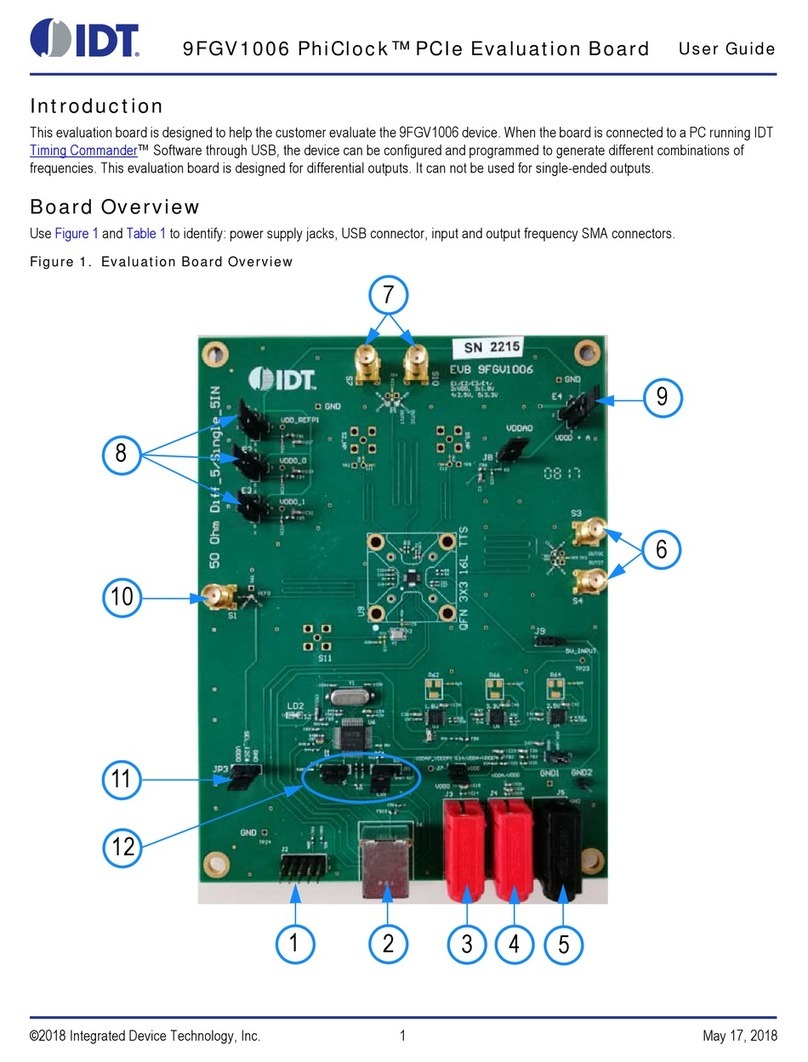
IDT
IDT 9FGV1006 User manual

IDT
IDT EB-LOGAN-23 User manual
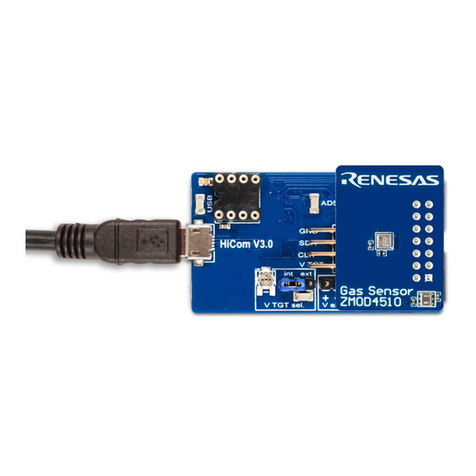
IDT
IDT ZMOD4510-EVK User manual
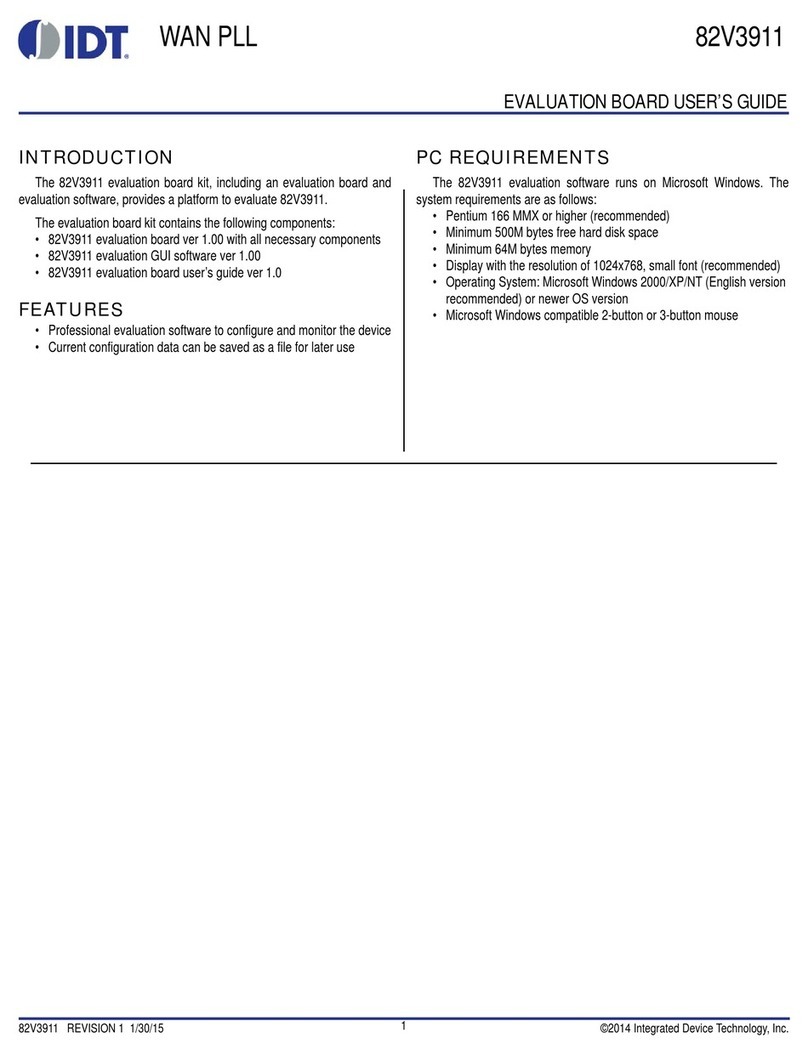
IDT
IDT 82V3911 User manual
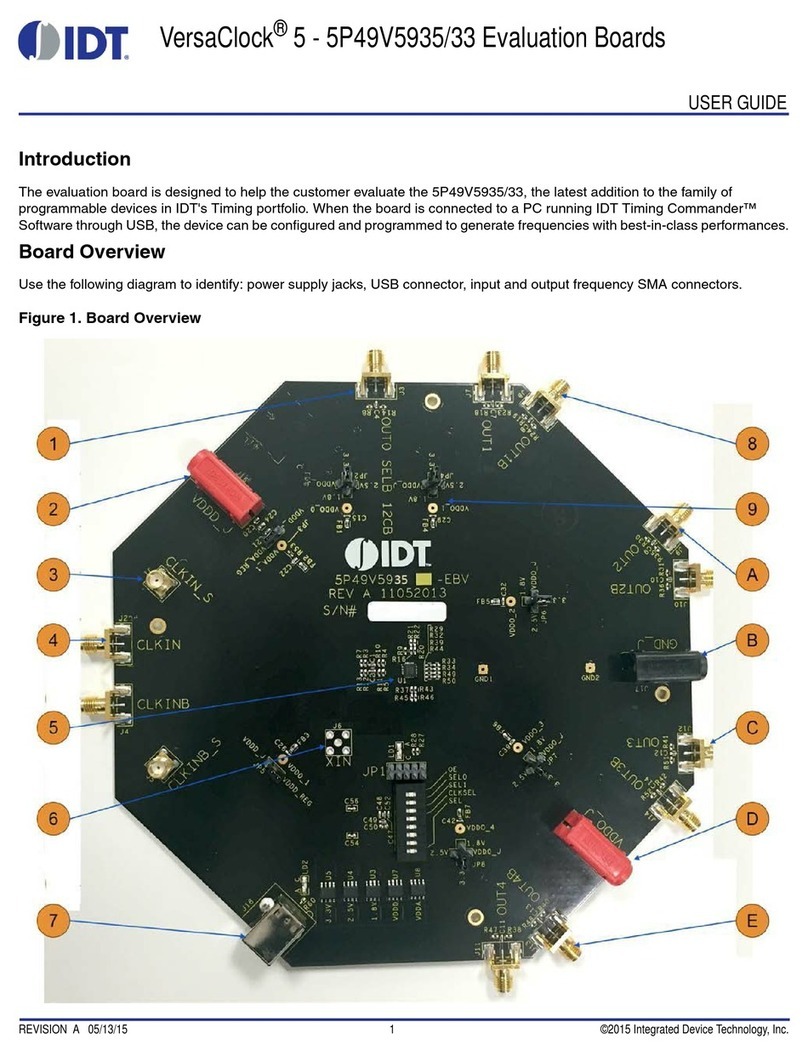
IDT
IDT VersaClock 5 User manual
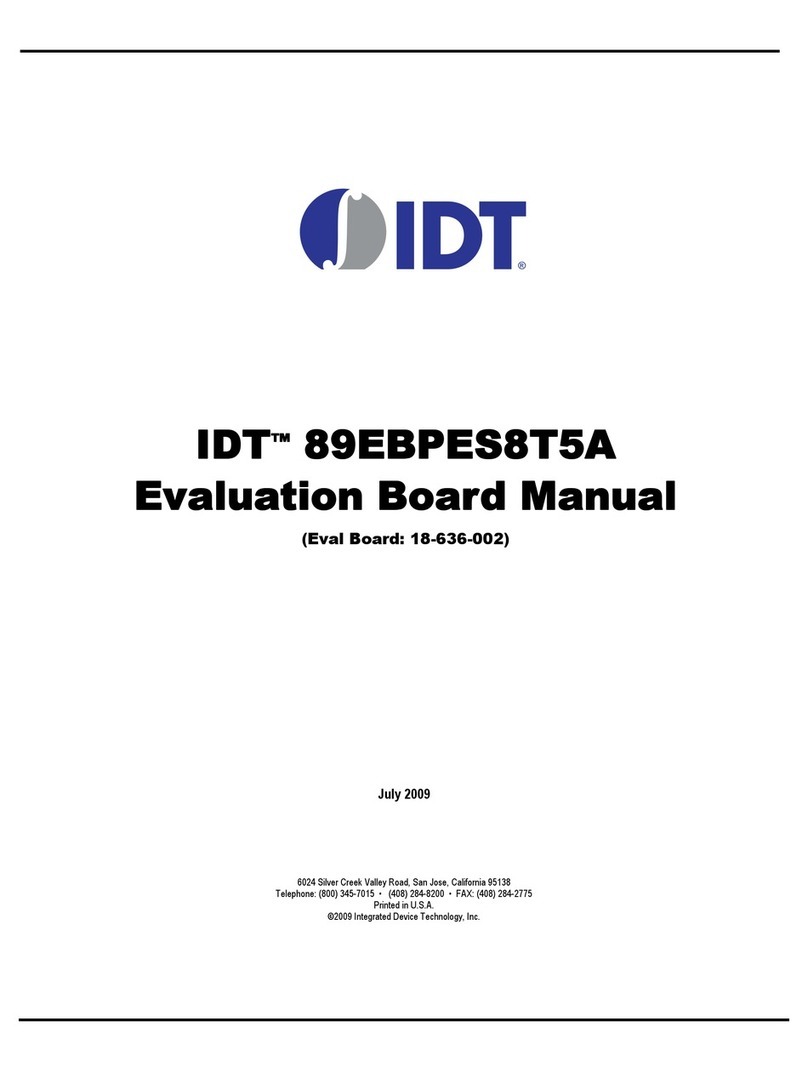
IDT
IDT EB8T5A Eval Board User manual
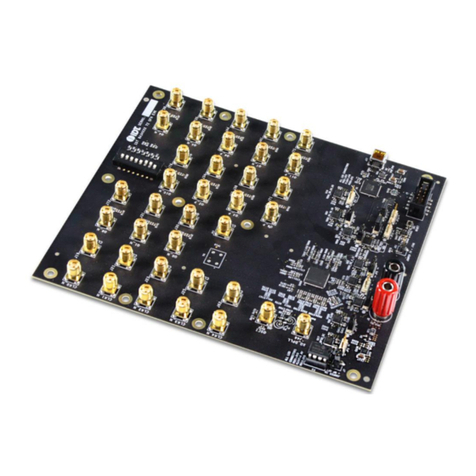
IDT
IDT 8A 72QFN Series User manual
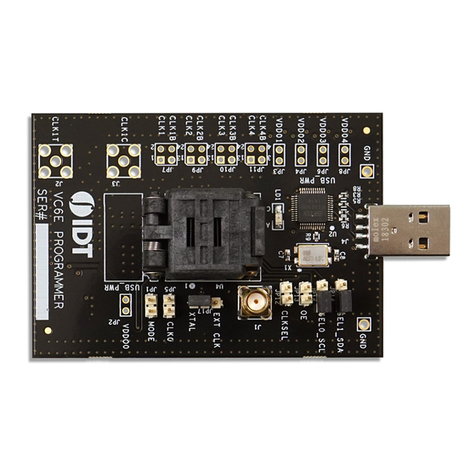
IDT
IDT VersaClock 6E 5P49V6965 User manual

IDT
IDT 9ZXL1951D User manual
